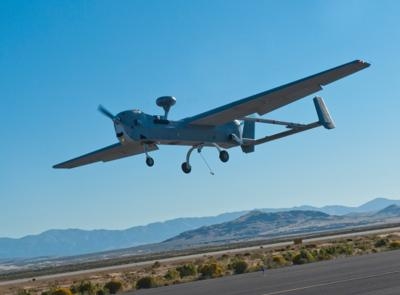Wed, Jan 15, 2014
U.S. Army Has Flown The Aircraft Since 1996
Northrop Grumman Corporation's Hunter Unmanned Aircraft System (UAS), in use with the U.S. Army since 1996, recently surpassed 100,000 combat flight hours in service. The MQ-5B Hunter, which is currently deployed supporting contingency operations across the globe, provides warfighters with state-of-the-art reconnaissance, surveillance, target acquisition (RSTA), communications relay and weapons delivery.

"Our very close working relationship with our Army customer has been critical to the program's enduring success," said Steve Hogan , vice president and general manager, Integrated Logistics and Modernization division, Northrop Grumman Technical Services. "The team's innovative partnering approach has been seamless over the years. The team has established an impeccable track record of continuous modernization and highly reliable performance while serving on the front lines shoulder-to-shoulder with our nation's warfighters in combat operations."
The RQ-5A Hunter was the Army's first fielded UAS. The MQ-5B is the next-generation Hunter, continuing a legacy of service to Army corps, division and brigade warfighters. Flying over the battlefield with its multimission optronic payload, the MQ-5B gathers RSTA information in real time and relays it via video link to commanders and soldiers on the ground.
The MQ-5B Hunter is distinguished by its heavy fuel engines, its "wet" (fuel-carrying) extended center wing with weapons-capable hard points and a modern avionics suite. The MQ-5B Hunter system uses the Army's One System ground control station and remote video terminal. It also carries a communications relay package to extend the radio range of warfighters. Hunter is also equipped with a differential GPS automatic takeoff and landing system. "This significant milestone is a credit to the sustained exceptional high levels of performance and technical expertise, dedication, professionalism and pride of all of our Northrop Grumman engineers, maintainers and operators," said Rob Sova , Hunter program manager, Northrop Grumman Technical Services. "This team lives and breathes our customer's mission and strives to exceed customer expectations every single day."
The MQ-5B features a robust, fixed-wing, twin tail-boom design with redundant control systems powered by two heavy fuel engines – one engine to "push" and another to "pull" the aircraft. Another Hunter capability is its relay mode that allows one Hunter to be controlled by another UAV at extended ranges or over terrain obstacles typical of those found in the Balkans and Afghanistan.
(Image provided by Northrop Grumman)
More News
Aero Linx: International Federation of Airworthiness (IFA) We aim to be the most internationally respected independent authority on the subject of Airworthiness. IFA uniquely combi>[...]
Ultrahigh Frequency (UHF) The frequency band between 300 and 3,000 MHz. The bank of radio frequencies used for military air/ground voice communications. In some instances this may >[...]
A Few Questions AND Answers To Help You Get MORE Out of ANN! 1) I forgot my password. How do I find it? 1) Easy... click here and give us your e-mail address--we'll send it to you >[...]
From 2019 (YouTube Edition): Learning To Paint Without Getting Any On Your Hands PPG's Aerospace Coatings Academy is a tool designed to teach everything one needs to know about all>[...]
Also: Sustainable Aircraft Test Put Aside, More Falcon 9 Ops, Wyoming ANG Rescue, Oreo Cookie Into Orbit Joby Aviation has reason to celebrate, recently completing its first full t>[...]
 ANN's Daily Aero-Linx (05.06.25)
ANN's Daily Aero-Linx (05.06.25) ANN's Daily Aero-Term (05.06.25): Ultrahigh Frequency (UHF)
ANN's Daily Aero-Term (05.06.25): Ultrahigh Frequency (UHF) ANN FAQ: Q&A 101
ANN FAQ: Q&A 101 Classic Aero-TV: Virtual Reality Painting--PPG Leverages Technology for Training
Classic Aero-TV: Virtual Reality Painting--PPG Leverages Technology for Training Airborne 05.02.25: Joby Crewed Milestone, Diamond Club, Canadian Pilot Insurance
Airborne 05.02.25: Joby Crewed Milestone, Diamond Club, Canadian Pilot Insurance



